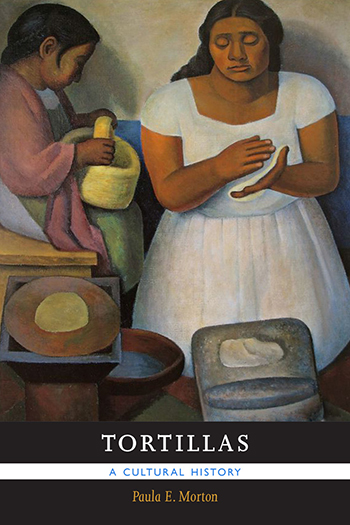
This week we ask Florida author and journalist Paula E. Morton some questions about her enthralling new book, Tortillas: A Cultural History, from the University of New Mexico Press, 2014.
New Mexico Mercury: How did you come to think of the tortilla as a vehicle with which to study history and society across cultures?
Paula E. Mortan: Before I was an author, I was a farmer in York County, Pennsylvania. It was a rich but demanding lifestyle, and after more than twenty years we headed west to Las Cruces in the southwest corner of New Mexico. The most I knew about tortillas was that they tasted good in Pennsylvania and were best at the borderlands, handmade and warm off the griddle. One day I worked for cheap pay as a temp employee in an immigrant-neighborhood tortillería across the U.S. border from Anapra, Mexico. I was curious. Who made the first tortilla? My Mexican neighbor patted round tortillas from corn dough, masa, imbued with the sweet flavor of fresh ground corn infused with mineral lime. What was the “authentic” tortilla, made the “natural way,” known as the nixtamal corn tortilla? Where did the wheat flour tortilla come from? How did the traditional corn and wheat flour tortilla morph into one of the most dynamic mass-produced foods in the world? The culture, environment, political complexities—I was, and continue to be, intrigued.
NMM: How long did it take you to research this remarkable work, and what was the sequence of revelations that showed themselves as you tracked the tortilla’s cultural history around the world?
PEM: I spent about two and a half years reading, interviewing, listening to tortilla stories, visiting small tortillerías and large production facilities, and writing the manuscript. To celebrate the tortilla, I went back in time to ancient Mesoamerica, where the gods created the first humans from corn dough and tortillas evolved into the Mesoamerican “bread of life.” The Maya buried their dead with tortillas so that the dogs eaten as dinner during life would not bite the deceased in revenge. Conscientious Mesoamerican cooks simmered the hard kernels of mature corn in an alkali solution of mineral lime and water, almost doubling the available protein and amino acids in corn, and thus, corn tortillas. As anthropologist Sophie Coe argued, “So superior is nixtamalized maize to the unprocessed kind that it is tempting to see the rise of Mesoamerican civilization as a consequence of this invention, without which the peoples of Mexico and their southern neighbors would have remained forever on the village level.”
I went on to explore the Spanish conquest of the Americas when the stubborn tortilla persevered in spite of the conquerors who introduced wheat and bread to the conquered. I moved forward in time to northern Mexico, the land of the enormous wheat flour tortilla, and to the frontier tortilla in present-day Texas, New Mexico, Arizona, and California. Then there is today, the time of the Americanization of the stuffed burrito and the global industrialized tortilla.
NMM: You focus deeply on the spiritual symbolism and the cultural bonding that the tortilla represents in Latin America. How did that first become apparent?
PEM: One of my first interviews took place in Anthony, New Mexico, with Eva Ybarra, who lived as a child in an isolated settlement of farm worker families in the Chihuahua high desert of northern Mexico. “When you are hungry, pray you have tortillas,” she says. “Tortillas are family ties, my mother’s devotion, and being Mexican.”
The Mesoamericans believed the tortilla had soul. Emma Yanes Rizo, a contemporary Otomí from Guanajuato, Mexico, embraces the tortilla as a bond between the human and divine. “The tortilla is a perfect circle that breaks away from an undefined mass, like the planets, or by the will of the woman who leaves it to sit on the fire. Prior to this, in the woman’s hands or the hands of a god, it was once a sphere, a lump of matter, whose circular shape can be discerned later on, as happens to those who gaze at the sun or at the moon.”
NMM: What has been the response to this broad-ranging but intensely focused book? Who has proven to be the most interested in it so far?
PEM: Tortillas are everywhere. The response to the story of the tortilla from Latinos to historians to foodies reflects the global and cross-cultural tortilla. Even in the United Kingdom the Times Literary Supplement describes Tortillas to its readers.
NMM: I was reminded of M. F. K. Fisher when I read this. It’s a beautifully written book about food, but it’s not a cookbook, though it does have the occasional recipe. What is it about studying food that lends itself to the revelation of intimate details about cultures and their ways of life?
PEM: “I want to tell you a tortilla story,” says Leonel Pérez, a Mam Maya from Guatemala. He is an immigrant farm worker who lives in Immokalee, Florida, a town that is home to many of Florida’s approximately thirty-three thousand tomato pickers. “My grandmother says if you have tortillas you have life; if you have corn you have life . . . no need to worry if you have tortillas.”
The tortilla can bring to mind images of cheap peasant food, undocumented migrants, immigrant factory sweatshops—or it can shift awareness to the rich cultural history of the tortilla and how the tortilla has changed the way we think about traditions, industrialized food, healthy cuisine, and the people who live across borders.
Tortillas: A Cultural History is available at bookstores or directly from the University of New Mexico Press at www.unmpress.com or 800.249.7737.



Responses to “Five Questions for New Mexico Authors - Paula E. Morton”